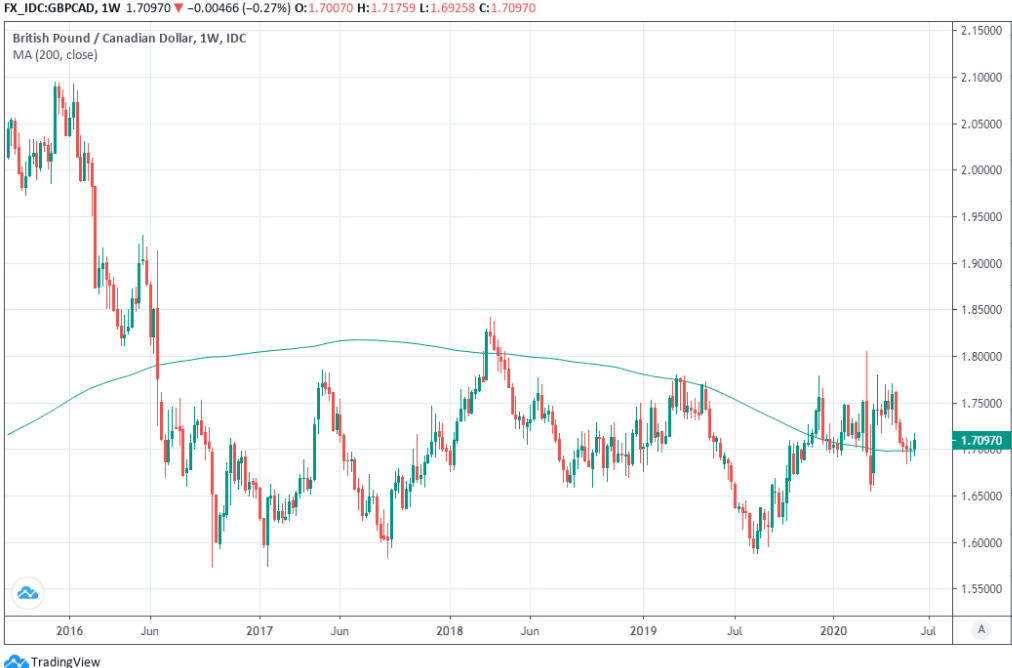Pound-Canadian Dollar Rate Establishing Foothold above 1.70
- Written by: James Skinner
-
- GBP/CAD finds foothold above 1.70 as underperformance subsides.
- Brexit talks to continue as Gov takes laissez-faire approach to ports.
- GBP regaining earlier place in FX pecking order but still vulnerable.

Image © Adobe Stock
Secure a retail exchange rate that is between 3-5% stronger than offered by leading banks, learn more.
The Pound-to-Canadian Dollar rate was treading water on Friday but has this week established a foothold around the midpoint of its recent trading ranges, leaving perched atop the 1.70 level and positioned for a modest recovery in the event that risk appetite continues to soften.
Sterling was treading water against the oil-linked Canadian Dollar as risk assets like stocks and commodities rebounded from earlier losses, after having overlooked a larger-than-expected fall in UK GDP for the month of April. The Pound-to-Canadian Dollar rate has bounced off its 200-week moving-average at 1.6984 and gone on to reclaim its 200-day average at 1.7073 this week as Sterling's earlier underperformance subsided, enabling the exchange rate to draw a line under the sharp declines seen in May.
This improvement in fortune comes after negotiators kicked the Brexit can down the road last week by agreeing to extend trade talks through the summer and as the UK government is reported by the FT to be adopting a laissez-faire approach to the trade border with Europe and the rest of the world. It will reportedly adopt a 'light touch' approach of effectively waving through imports after December 31 irrespective of whether there's a trade agreement with the EU.
"We believe there is a 50/50 chance that the UK either makes progress in talks with the EU or instead prepares for a hard Brexit, but with talks continuing into October’s summit," says Jordan Rochester, a strategist at Nomura.

Above: Pound-to-Canadian Dollar rate shown at daily intervals with 200-day moving-average.
The FT report follows lobbying from large companies, while the approach detailed in it would lessen any Brexit-related disruption to supply chains in the UK. However, it would do little to address possible export troubles in the event of a 'no deal Brexit' where the relationship is governed by World Trade Organization (WTO) terms. That would subject Europe-bound exports to a range of bureaucratic procedures and an average tariff that is in the low single digits.
Previously, fears were that trade talks would break down in June but the last fortnight has seen them extended while Prime Minister Boris Johnson has sought a meeting with European Commission President Ursula Von der Leyen. This combined with efforts by the government to reopen the economy has seen the market's relationship with the British currency at least appear to be thawing, but that has both up and downsides for the Pound-to-Canadian Dollar rate.
"GBP is still trading at weaker levels vs. both the EUR and the USD than at the start of the year. The return of Brexit concerns, the plummeting approval ratings of the government and fear that the BoE may resort to negative interest rates are all part of the problem for the pound," says Jane Foley, a senior FX strategist at Rabobank. "We expect that the BoE will increase its asset purchase facility by GBP 200 bln over the course of the summer starting with GBP 100 bln next week. We expect GBP to remain on the defensive."

Above: Pound Sterling performance against major rivals in month to June 12.
The Pound underperformed all comparable rivals in May but during the 20 trading days to June 12 it had eked out large gains over the safe-haven U.S. Dollar, Japanese Yen and Swiss Franc while also edging higher against the Canadian Dollar. As an oil-linked currency the Loonie is often more volatile than Sterling but the British currency underperformed its Canadian rival on both the good days and the bad last month.
Underperformance resulted from investor discontent with the domestic outlook while its tentative gain over the Canadian Dollar in recent weeks could be taken as evidence of a more neutral view on the part of the market. More so after the Pound-to-Canadian Dollar rate rose in the Thursday session as the stock markets that Sterling and the Loonie often follow, tumbled to their worst intraday losses since March. It didn't do that during bouts of risk aversion in May.
Stock markets surged last month as risk appetite was bolstered by moves and plans to reopen economies, not to mention speculation about a possible coronavirus vaccine, but decllines over three separate trading days in the first half of May were met with a lower Pound-to-Canadian Dollar rate. There was a larger number of intraday instances where the GBP/CAD and S&P 500 correlation appeared to turn positive that month.
"SP500 dominance as sole explanatory factor on average for the last 10 weeks in our multivariate framework is simply unprecedented," says Ben Randol at BofA Global Research. "Eventually, equity factor dominance will fade, and FX will once again reflect macro fundamentals. Our analysis suggests this could be starting to happen. Interest rate differential beta coefficients are beginning to rise toward more "normal" levels for some pairs, approaching thresholds of statistical significance. These include GBP/USD, USD/CAD and AUD/USD (for EUR/USD the coefficient is actually negative at present). To the extent that relative interest rates and the dollar reflect the broader relative growth cycle, this is a positive sign that fundamentals will start to matter for FX again."

Above: BofA Global Research graph showing currency sensitivities to changes in interest rate spreads.
Recent Brexit developments and Sterling's resilience on Thursday could see the Pound-to-Canadian Dollar rate drawing support on the days where risk aversion dominates in financial markets, but come under pressure as the market mood brightens. The Pound rose 0.46% against the Loonie Thursday when the all-important stock markets, which have dicated the mood in the currency market since late March, were falling but the Pound-to-Canadian Dollar rate fell -0.27% when stocks rebounded Friday.
This means fears of a second wave of coronavirus infections, or concerns about the outlook for the global economy may be reflected by a higher Pound-to-Canadian Dollar rate again, while optimism about the recovery weighs on it. However, Sterling might also be disadvantaged if BofA Global Research is right about the stock market influence waning as the importance of economic fundamentals picks up in the weeks ahead.
That leaves the Pound susceptible to renewed concerns about the Brexit talks at a later date and setbacks for a domestic economy that's a long way from out of the woods. Either of those might be enough to engineer fresh underperformance in Sterling and if combined together would make for an environment not too dissimilar to the one that sent the Pound-to-Canadian Dollar rate some five percent lower from peak of 1.77 to its trough of 1.68 during May.
Sterling was this week tipped by Scotiabank to stabilise "if a foothold above 1.7110 is achieved" and had previously been forecast by BMO Capital Markets to recover that level in June. But both project a lower Pound-to-Canadian Dollar rate by year-end, with Scotiabank looking for 1.68 while BMO tips 1.65.

Above: Pound-to-Canadian Dollar rate shown at weekly intervals with 200-week moving-average.









